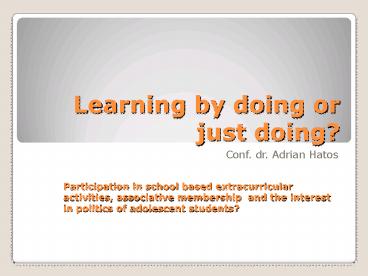Learning by doing or just doing PowerPoint PPT Presentation
1 / 17
Title: Learning by doing or just doing
1
Learning by doing or just doing?
- Conf. dr. Adrian Hatos
Participation in school based extracurricular
activities, associative membership and the
interest in politics of adolescent students?
2
The good democratic citizen
- Actively involved in politics
- Politically competent
- Strongly attached to democratic values like
tolerance - The Problem
- Participation deficitDemocratic deficit
- Lowered voter turnout are explained greatly by
youth absenteism - Yout is less and less interested and informed in
matters of politics (Hooghe, 2004) - The top of political interest is attained during
early adolescence (Easton Hess, 1962) - It is, evidently a problem of political
socialization
3
The political interest among Romanian youth is
relatively large
- Adults
- UE 17 (ESS, 2006)
- România 20-25 (Com?a, 2007)
- Youth
- IEA 1999 anticipated political participation
above the international average (Torney-Purta,
2002) - 36 of youth declared themseves interested in
national problems (Strâmbeanu, 2004) - For 90 of teenagers (aged 14 to18) entertainment
is on the top of their concerns while politics
comes last (Strâmbeanu, 2004)
4
Research questions
- What is the distribution of political involvement
of youth aged 13 to 18 in Oradea? - Which are the covariates of political
participation of youth aged 13 to 18 in Oradea? - What is the effect of school based
extracurricular activities on political
participation of adolescents?
5
Educating citizens in school
- The potential for civic socialization of formal
civic education is quite limited (Galston, 2004) - Non/Informal civic socialization seems to be of
great value student parliaments and
organizations (Torney- Purta, 2002),
participative methods are of greatest impact
(Finkel, 2003) - Effectiveness of school-based extracurricular
activities is to be assesed
6
Impact of SBEA (school based extracurricular
activities)
- General positive effects (Feldman Matjasko,
2005 Fredricks Eccles, 2005, 2006) - Structured SBEA have positive effects better
school results, lower dropout rates, lowered
incidence of drug consumption, better
psychological adjustment, lower delinquence - SBEA effects depend on
- Friends, peers, networks (ex. Crosnoe, 2002)
- Type of activities (Feldman Matjasko, 2005)
- SBEA effects on civic attitudes are less often
approached - Zaff, Moore, Papillo, Williams, 2003
consistent involvement in SBEA ? better academic
results, prosocial behavior, 50 increase in
probability of vote - Strambeanu (2005) school activism is an
important covariate of political participation of
adolescents aged 14 to 18
7
Predictors of adult political participation
- Nie, Junn si Strehlik-Bahry (1996) verbal
competence, organizational membership, network
centrality and education. - Com?a (2007) Strongest predictors length of
schooling, perceived political competence.
8
Other classes of predictors
- SES
- Education 1) status, status reproduction 2)
competence and elimination of cognitive
constraints - Gender political involvement is gender specific.
Men are more involved in politics than women. - Voluntary membership
- Putnamians involvement in voluntary associations
is a fertilizer of social participation including
that of democratic political participation and of
generalized trust - Evidences Verba et al 1995 Niemi, 1998 Dekker,
1997 Com?a, 2007. - Critics it is not true that participation
produces democratic attitudes - (Stolle, 1998 Uslaner, 2002, Rossteutscher,
2002)
9
?
?
?
?
10
Data, variables, method
- Second wave of survey Adolescents, future
citizens. (november, december, 2007) - N2985 (grades 8-12) random, stratified,
cluster sampling
11
Interest for politics
- Additive scale of three Likert items
- I know more about politics than most of the youth
of my age - I am interested in politics
- I feel close to the values, principles and the
leaders of a political party - Missing values replaced with the item medians.
12
SBEA
- Measure of SBEA participation count of type of
SBEA activities involved in excluding proms and
parties - Associative membership number of voluntary
associations the person is member of (85 belong
to no association, the average is 0,32) - Type of leisure 2 factor scores of six measures
1) social leisure 2) cultivated leisure
13
Distribution of political index interest
alpha 0,82
14
Results
- OLS regression
- Path analysis
15
R20,13
16
(N2961 RMSEA0,037, CFI0,975 parametri
standardizati)
17
Conclusions
Class habitus
Gender
Political participation
- Personal characterics -- social activism
- Extroversion
- Intelligence

